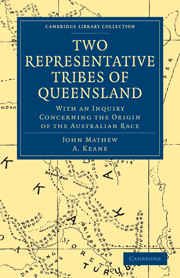 Two Representative Tribes of Queensland
Two Representative Tribes of Queensland Book contents
- Frontmatter
- Contents
- LIST OF ILLUSTRATIONS
- INTRODUCTION
- PREFACE
- CHAP. I INQUIRY CONCERNING THE ORIGIN OF THE AUSTRALIAN RACE
- CHAP. II THE COUNTRY OF THE KABI AND WAKKA TRIBES
- CHAP. III PHYSICAL AND MENTAL CHARACTERS
- CHAP. IV DAILY LIFE—SHELTER—FOOD—CLOTHING
- CHAP. V MAN-MAKING AND OTHER CEREMONIES
- CHAP. VI DISEASE AND TREATMENT—DEATH—BURIAL AND MOURNING
- CHAP. VII ART—IMPLEMENTS—UTENSILS—WEAPONS—CORROBOREES
- CHAP. VIII SOCIAL ORGANISATION
- CHAP. IX THE FAMILY—KINSHIP AND MARRIAGE
- CHAP. X RELIGION AND MAGIC
- CHAP. XI MYTHS AND LEGENDS
- CHAP. XII LANGUAGE
- VOCABULARY
CHAP. VII - ART—IMPLEMENTS—UTENSILS—WEAPONS—CORROBOREES
Published online by Cambridge University Press: 29 August 2010
- Frontmatter
- Contents
- LIST OF ILLUSTRATIONS
- INTRODUCTION
- PREFACE
- CHAP. I INQUIRY CONCERNING THE ORIGIN OF THE AUSTRALIAN RACE
- CHAP. II THE COUNTRY OF THE KABI AND WAKKA TRIBES
- CHAP. III PHYSICAL AND MENTAL CHARACTERS
- CHAP. IV DAILY LIFE—SHELTER—FOOD—CLOTHING
- CHAP. V MAN-MAKING AND OTHER CEREMONIES
- CHAP. VI DISEASE AND TREATMENT—DEATH—BURIAL AND MOURNING
- CHAP. VII ART—IMPLEMENTS—UTENSILS—WEAPONS—CORROBOREES
- CHAP. VIII SOCIAL ORGANISATION
- CHAP. IX THE FAMILY—KINSHIP AND MARRIAGE
- CHAP. X RELIGION AND MAGIC
- CHAP. XI MYTHS AND LEGENDS
- CHAP. XII LANGUAGE
- VOCABULARY
Summary
The tribes of Central and North - Central Australia, having been recently minutely described in all the uncanny, uncouth, and picturesque details of unsophisticated savage life, there is a liability to imagine that they represent the most primitive phase of Australian aboriginal culture. But in many respects they are more highly advanced than those tribes with which we have been long familiar, who occupy, or have occupied, the early settled districts. The territory of the central tribes is very extensive, and is easily accessible to influence from the north, the direction from which advances in Australia have always come. The distribution of circumcision is one evidence of greater accessibility to foreign influence and, besides, art, as exhibited in weapons, ornaments and implements, is much more highly developed in the north and centre of Australia than along the east coast. The rivers emptying into the Pacific and Indian Oceans have formed barriers to intercourse, whereas, on the contrary, rivers flowing into the Gulf of Carpentaria have been like highways leading inwards, and the ranges running east and west once crossed, numerous other water-courses, which converge upon the very heart of the continent, have facilitated the introduction of higher culture.
The tribes under notice, like most tribes on the east coast, were kept to a large extent isolated by river and mountain barriers. Several facts indicate their peculiar primitiveness.
- Type
- Chapter
- Information
- Two Representative Tribes of QueenslandWith an Inquiry Concerning the Origin of the Australian Race, pp. 117 - 127Publisher: Cambridge University PressPrint publication year: 2010First published in: 1910


